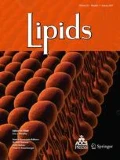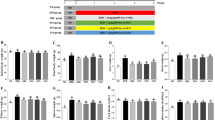Abstract
Celastrus orbiculatus Thunb. (COT), a traditional Chinese herb, has anti-inflammatory and anti-oxidative properties. In this study, we examined the protective effect of COT on the initiation of atherosclerosis induced by high fat diet and explored the underlying mechanisms. We established guinea pig models of hyperlipidemia and treated them with three dosages of COT or 20 mg/kg/d simvastatin (a positive control drug) for 8 weeks. Plasma lipid analysis indicated that COT decreased total cholesterol (TC), non-high-density lipoprotein cholesterol (non-HDL-C), triglyceride (TG), apolipoprotein B100 (apoB100) and apolipoprotein E (apoE) levels and increased high density lipoprotein cholesterol (HDL-C) level. The analysis of the hepatic gene involving cholesterol metabolism by quantitative real-time PCR revealed that COT upregulated the mRNA abundance of LDL receptor (LDL-R), scavenger receptor class B type 1 (SR-B1), cholesterol 7α-hydroxylase A1 (CYP7A1) and the 3-hydroxy-3-methyl-glutaryl-CoA reductase (HMGCR). Oil red O staining showed COT significantly reduced lipid deposition in the arterial wall. Moreover, ELISA assay revealed COT lowered the levels of C-reactive protein (CRP), interleukin-6 (IL-6), and tumor necrosis factor-α (TNF-α) in plasma. Meanwhile, the level of Nitric oxide (NO) in plasma was increased by COT. Immunohistochemistry and Western blot analysis showed the expression of CD68 and active NF-kB p65 proteins in the arterial wall was decreased by COT. The content of Malondialdehyde (MDA) and activity of Superoxide dismutase (SOD) in plasma were determined and the data indicated COT suppressed oxidative stress reaction. These results reveal that administration of COT decreases athero-susceptibility through lowering plasma lipid, attenuating inflammation, and suppressing oxidative stress in guinea pig fed high fat diet.







Similar content being viewed by others
Abbreviations
- COT:
-
Celastrus orbiculatus Thunb
- AS:
-
Atherosclerosis
- TC:
-
Total cholesterol
- TG:
-
Triglyceride
- HDL-C:
-
High density lipoprotein cholesterol
- LDL-C:
-
Low density lipoprotein cholesterol
- apoB:
-
Apolipoprotein B
- TNF-α:
-
Tumor necrosis factor-α
- IL:
-
Interleukin
- CRP:
-
C-reactive protein
- SDS-PAGE:
-
Sodium dodecyl sulfate polyacrylamide gel electrophoresis
- MDA:
-
Malondialdehyde
- SOD:
-
Superoxide dismutase
- LDL-R:
-
LDL receptor
- SR-B1:
-
Scavenger receptor Class B Type 1
- HMGCR:
-
3-hydroxy-3-methyl-glutaryl-CoA reductase
- CYP7A1:
-
Cholesterol 7α-hydroxylase A1
- NO:
-
Nitric oxide
References
Libby P (2002) Inflammation in atherosclerosis. Nature 420:868–874
Ross R (1993) The pathogenesis of atherosclerosis: a perspective for the 1990s. Nature 362:801–809
Lazebnik LB, Ovsiannikova ON, Zvenigorodskaia LA, Mel’nikova NV, Samsonova NG, Khomeriki SG (2008) Cholesterosis of the gall bladder and atherogenic dyslipidemia: etiology, pathogenesis, clinical symptoms, diagnosis, and treatment. Ter Arkh 80:57–61
Ross R (1999) Atherosclerosis—an inflammatory disease. N Engl J Med 340:115–126
Chen F, Castranova V, Shi X, Demers LM (1999) New insights into the role of nuclear factor-κB, an ubiquitous transcription factor in the initiation of diseases. Clin Chem 45:7–17
Ridker PM, Stampfer MJ, Rifai N (2001) Novel risk factors for systemic atherosclerosis: a comparison of C-reactive protein, fibrinogen, homocysteine, lipoprotein(a), and standard cholesterol screening as predictors of peripheral arterial disease. J Am Med Assoc 285:2481–2485
Jin HZ, Hwang BY, Kim HS, Lee JH, Kim YH, Lee JJ (2002) Antiinflammatory constituents of Celastrus orbiculatus inhibit the NF-kappaB activation and NO production. J Nat Prod 65:89–91
Chapman MJ, Mills GL, Ledford JH (1975) The distribution and partial characterization of the serum apolipoproteins in the guinea pig. Biochem J 149:423–436
Jiang XC, Bruce C, Mar J, Lin M, Ji Y, Francone OL, Tall AR (1999) Targeted mutation of plasma phospholipid transfer protein gene markedly reduces high-density lipoprotein levels. J Clin Invest 103:907–914
Sherman MP, Aeberhard EE, Wong VZ, Griscavage JM, Ignarro LJ (1993) Pyrrolidine dithiocarbamate inhibits induction of nitric oxide synthase activity in rat alveolar macrophages. Biochem Biophys Res Commun 191:1301–1308
Fridovich I (1983) Superoxide radical: an endogenous toxicant. Annu Rev Pharmacol Toxicol 23:239–257
Chen J, Zhao H, Ma X, Han X, Luo L, Wang L, Han J, Liu B, Wang W (2012) The effects of Jiang-Zhi-Ning and its main components on cholesterol metabolism. Evid Based Complement Alternat Med 2012:928234
Nam KH, Choi JH, Seo YJ, Lee YM, Won YS, Lee MR, Lee MN, Park JG, Kim YM, Kim HC, Lee CH, Lee HK, Oh SR, Oh GT (2006) Inhibitory effects of tilianin on the expression of inducible nitric oxide synthase in low density lipoprotein receptor deficiency mice. Exp Mol Med 38:445–452
Collins T, Cybulsky MI (2001) NF-kappaB: pivotal mediator or innocent bystander in atherogenesis? J Clin Invest 107:255–264
Tsubosaka Y, Murata T, Yamada K, Uemura D, Hori M, Ozaki H (2010) Halichlorine reduces monocyte adhesion to endothelium through the suppression of nuclear factor- κB activation. J Pharmacol Sci 113:208–213
Tsutsui H (2006) Mitochondrial oxidative stress and heart failure. Intern Med 45:809–813
Seddon M, Looi YH, Shah AM (2007) Oxidative stress and redox signalling in cardiac hypertrophy and heart failure. Heart 93:903–907
Rudkowska I, Jones PJ (2007) Functional foods for the prevention and treatment of cardiovascular diseases: cholesterol and beyond. Expert Rev Cardiovasc Ther 5:477–490
Guo YQ, Li X, Lee JJ, Xu J, Li N, Meng DL, Wang JH (2006) A new sesquiterpene ester inhibiting no production from the fruits of Celastrus orbiculatus. J Asian Nat Prod Res 8:739–742
Blankstein R, Budoff MJ, Shaw LJ, Goff DC Jr, Polak JF, Lima J, Blumenthal RS, Nasir K (2011) Predictors of coronary heart disease events among asymptomatic persons with low low-density lipoprotein cholesterol MESA (Multi-Ethnic Study of Atherosclerosis). J Am Coll Cardiol 58:364–374
Gotto AM Jr (1995) Lipid lowering, regression, and coronary events. A review of the interdisciplinary council on lipids and cardiovascular risk intervention, Seventh Council meeting. Circulation 92:646–656
Spady DK, Cuthbert JA, Willard MN, Meidell RS (1996) Feedback regulation of hepatic 7alpha-hydroxylase expression by bile salts in the hamster. J Biol Chem 271:18623–18631
Grundy SM (2002) Low-density lipoprotein, non-high-density lipoprotein, and apolipoprotein B as targets of lipid-lowering therapy. Circulation 106:2526–2529
Garg R, Vasamreddy CR, Blumenthal RS (2005) Non-high-density lipoprotein cholesterol: why lower is better. Prev Cardiol 8:173–177
Shefer S, Nguyen LB, Salen G, Ness GC, Chowdhary IR, Lerner S, Batta AK, Tint GS (1992) Differing effects of cholesterol and taurocholate on steady state hepatic HMG-CoA reductase and cholesterol 7α-hydroxylase activities and mRNA levels in the rat. J Lipid Res 33:1193–1200
Brown MS, Goldstein JL (1986) A receptor-mediated pathway for cholesterol homeostasis. Science 232:34–47
Grundy SM, Cleeman JI, Merz CN, Brewer HB Jr, Clark LT, Hunninghake DB, Pasternak RC, Smith SC Jr, Stone NJ (2004) Implications of recent clinical trials for the National Cholesterol Education Program Adult Treatment Panel III guidelines. Circulation 110:227–239
Brown MS, Goldstein JL (1981) Lowering plasma cholesterol by raising LDL receptors. N Engl J Med 305:515–517
Hampton R, Dimster-Denk D, Rine J (1996) The biology of HMG-CoA reductase: the pros of contra-regulation. Trends Biochem Sci 21:140–145
Chiang JY, Kimmel R, Stroup D (2001) Regulation of cholesterol 7alpha-hydroxylase gene (CYP7A1) transcription by the liver orphan receptor (LXRalpha). Gene 262:257–265
Madamanchi NR, Vendrov A, Runge MS (2005) Oxidative stress and vascular disease. Arterioscler Thromb Vasc Biol 25:29–38
Francisco G, Hernández C, Simó R (2006) Serum markers of vascular inflammation in dyslipemia. Clin Chim Acta 369:1–16
Basu SK, Brown MS, Ho YK, Havel RJ, Goldstein JL (1981) Mouse macrophages synthesize and secrete a protein resembling apolipoprotein E. Proc Natl Acad Sci USA 78:7545–7549
Wang CY, Chang TC (2004) Non-HDL cholesterol level is reliable to be an early predictor for vascular inflammation in type 2 diabetes mellitus. J Clin Endocrinol Metab 89:4762–4767
Ayaori M, Sawada S, Yonemura A, Iwamoto N, Ogura M, Tanaka N, Nakaya K, Kusuhara M, Nakamura H, Ohsuzu F (2006) Glucocorticoid receptor regulates ATP-binding cassette transporter-A1 expression and apolipoprotein-mediated cholesterol efflux from macrophages. Arterioscler Thromb Vasc Biol 26:163–168
Islam MS, Yoshida H, Matsuki N, Ono K, Nagasaka R, Ushio H, Guo Y, Hiramatsu T, Hosoya T, Murata T, Hori M, Ozaki H (2009) Antioxidant, free radical-scavenging, and NF-kappaB-inhibitory activities of phytosteryl ferulates: structure-activity studies. J Pharmacol Sci 111:328–337
Mudau M, Genis A, Lochner A, Strijdom H (2012) Endothelial dysfunction: the early predictor of atherosclerosis. Cardiovasc J Afr 23:222–231
Seppo L, Karjala K, Nevala R, Korpela R, Lähteenmäki T, Solatunturi E, Tikkanen MJ, Vapaatalo H (2000) A long-term fish diet modifies the toxic properties of human partially oxidized LDL on vascular preparations in vitro. J Physiol Pharmacol 51:251–265
Vidal F, Colomé C, Martínez-González J, Badimon L (1998) Atherogenic concentrations of native low-density lipoproteins down-regulate nitric oxide synthase mRNA and protein levels in endothelial cells. Eur J Biochem 252:378–384
Fernandez ML, Yount NY, McNamara DJ (1990) Whole body cholesterol synthesis in the guinea pig: effects of dietary fat quality. Biochim Biophys Acta 1044:340–348
Grove D, Pownall HJ (1991) Comparative specificity of plasma lecithin: cholesterol acyltransferase from ten animal species. Lipids 26:416–420
Angelin B, Olivecrona H, Reihner H et al (1992) Hepatic cholesterol metabolism in estrogen-treated men. Gastroenterol 103:1657–1663
Reihner E, Angelin B, Rudling M, Ewerth S, Bjorkhem I, Einarsson K (1990) Regulation of hepatic cholesterol metabolism in humans: stimulatory effects of cholestyramine on HMG-CoA reductase activity and low density lipoprotein receptor expression in gallstone patients. J Lipid Res 31:2219–2226
Fernandez ML, Ruiz LR, Conde AK, Sun C-M, Erickson S, McNamara DJ (1995) Psyllium reduces plasma LDL in guinea pigs by altering hepatic cholesterol metabolism. J Lipid Res 36:1128–1138
Reihner E, Angelin B, Bjorkhem I, Einarsson K (1991) Hepatic cholesterol metabolism in cholesterol gallstone disease. J Lipid Res 32:469–475
Xiangdong L, Yuanwu L, Hua Z et al (2011) Animal models for the atherosclerosis research: a review. Protein Cell 2:189–201
Ensign WY, McNamara DJ, Fernandez ML (2002) Exercise improves plasma lipid profiles and modifies lipoprotein composition in guinea pigs. J Nutr Biochem 13:747–753
West Kristy L, Fernandez Maria Luz (2004) Guinea pigs as models to study the hypocholesterolemic effects of drugs. Cardiovasc Drug Rev 22:55–70
Puppione DL, Sardet C, Yamanaka W et al (1971) Plasma lipoproteins of cholesterol-fed guinea pigs. Biochim Biophys Acta 231:295–301
Wright JL, Churg A (2002) A model of tobacco smoke-induced airflow obstruction in the guinea pig 121(5 Suppl):188S–191S
Acknowledgments
This research was supported by the financial donations from the Taishan scholar foundation of Shandong Province (200867) and the Natural Science Foundations of China (30971098 and 81070247), and the Special Research Funding of Taishan Medical University(2008).
Author information
Authors and Affiliations
Corresponding author
Additional information
Y. Zhang, Y. Si and S. Yao contributed equally to this study.
About this article
Cite this article
Zhang, Y., Si, Y., Yao, S. et al. Celastrus orbiculatus Thunb. Decreases Athero-Susceptibility in Lipoproteins and the Aorta of Guinea Pigs Fed High Fat Diet. Lipids 48, 619–631 (2013). https://doi.org/10.1007/s11745-013-3773-7
Received:
Accepted:
Published:
Issue Date:
DOI: https://doi.org/10.1007/s11745-013-3773-7




